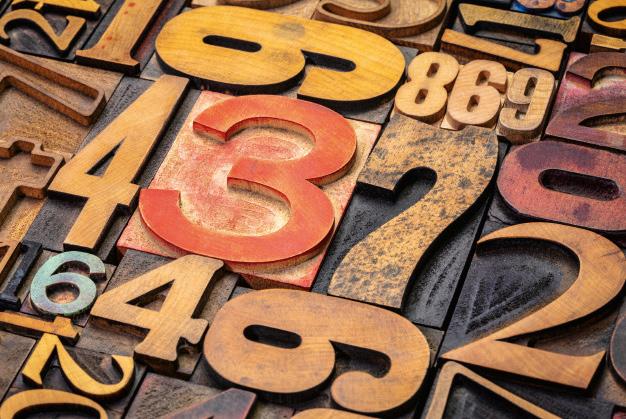
4 minute read
NATURAL NUMBERS AND INTEGERS 1
Natural numbers have been used since ancient times by all civilisations. The most ancient societies used them to count objects, while the ancient Greeks also theorised about them, just for the joy of it.
Pythagoras (6TH century BC) and his disciples attributed divine, mystical powers to numbers. They believed that numbers governed everything: music, the movements of the planets, geometry, etc.
They investigated their properties and the relationships between them, as well as classifying them. This knowledge was later collected in Book 7 of Euclides' Elements.
Negative numbers arrived long after natural numbers, in order to meet the needs of commerce, and following the integration of the number zero, which was essential to their existence.
Negative numbers were not systematised until the 7TH century in Indian writings about everyday questions such as what people had compared to what they owed 'A debt subtracted from nothing becomes an asset.’. 'An asset subtracted from nothing becomes a debt.’.
Statements like this demonstrate that they used the concept of zero and the rule of sign.
The introduction of negative numbers to Europe, via the Arabs, was slow and uneven. A number of mathematicians theorised about them from the 17TH, century, but it was not until the end of the 19TH century that the set of negative integers was accepted and recognised as a mathematical object in its own right.
Use what you have learned to solve this problem
A group of friends are collecting NBA stickers, with 18 teams. Each team takes up a double-page spread in the album and includes 16 stickers of the players, one of the coach and one of the club logo.
1 Yesterday Marcos had 73 stickers in his album and 27 duplicates to swap. Today he bought three packs of 5 stickers, which contained six that he already had. Later on he swapped 13 of his duplicates with Marta for missing stickers. Answer the following questions in the order they appear, and join each one to the equations on the right.
a) How many stickers are in the collection?
b) How many pages does the album have if the first page is the table of contents and the last page the credits?
c) By how many more stickers has Marcos increased his collection today?
d) How many non-duplicates does he have now?
e) How many duplicates does he have?
f) How many stickers does he still need to complete his collection?
2 Rodrigo has 42 duplicates and wants to sort them in equal piles, each with between 5 and 10 stickers. How many different ways can he do this?
3 Alberto says that when he has 250 stickers, without duplicates, he will have filled 13 pages of his album. Adela does not agree, saying that he might not have filled a single one. Ramiro thinks that he might have filled three of four pages, but probably not any more. Who do you think has the most possibility of being right? Explain your answer.
4 Noemí has 310 stickers and only needs a few more to complete her collection. What is the minimum number of pages of the album she has completed? And the maximum?
Mayan numerals
Investigate the characteristics and rules of the Mayan numeral system.
8 238
The Set Of Natural Numbers
The numbers we use to count objects one by one are called natural numbers. The set of natural numbers is represented with the letter N. It has a beginning and an order, but it has no end.
N = {0, 1, 2, 3, 4, …}
Natural numbers are represented and ordered on a number line.
The decimal numeral system
Since the dawn* of civilisation, different cultures have devised different ways of expressing natural numbers. We call these numeral systems. H
Focus on English dawn: the beginning of a period of time.
We usually use the decimal numeral system (DNS). It was invented in India and brought to the Mediterranean by the Arabs during the expansion of the Arabic world, in the 8th century.
The decimal numeral system is a positional system, which means that each digit has a place value.
Remember
The use of 10 as the basis for the decimal numeral system is derived from the primitive method of counting with the fingers.
It is a decimal system because ten units of any place value make one unit of the place value immediately above.
Therefore, a number can be decomposed as shown in the following example (polynomial decomposition):
The sexagesimal system
In the same way that we count in 10s (decimal system), other cultures throughout history have counted in 60s (sexagesimal system).
The number 60 was probably adopted as a way of counting with the 12 phalanges of the index, middle, ring and little fingers, using the thumb as a guide, and the other hand for keeping count.
➜ measuring time and angles
Nowadays, we use the sexagesimal system to measure time and angles. In these magitudes, each place value is divided into 60 units of the place value immediately below.
5 x 12 = 60
anayaeducacion.es
Express magnitudes in simple and complex form.
Notice that the symbols used for the minutes and seconds are different for each magnitude.
➜ complex and simple expressions
Remember that the measurement of amounts associated with a magnitude can be expressed simultaneously in several units (complex form) or in a single unit (simple form).
Consolidating ideas
Copy and complete in your notebook.
1 Express in complex form: a) In minutes: 2 h 24 min 8 (2 · 60 + 24) min = (… + …) min = … min b) In seconds: 2 h 24 min 8 (2 · 3 600 + 24 · …) s = … s
2 Express 2 hours and 24 minutes in simple form (first in minutes and then in seconds).





